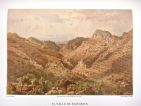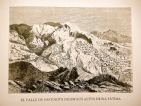
Valldemossa and El Teix
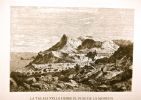 "The tall, almost conical Puig de la Moneda behind Son Olesa represents the limit of the plain. There are pines on the slopes and clearings and thickets on the summit from where there is a view of all the valley’s surroundings: Talaia Vella, Talaia de Valldemossa, the promonotory called Muntanya de Can Prom, the headlands of Port and Foradada valleys and the peaceful hermitage. On the other side, we see Valldemossa Valley, Son Gual and Coma, elevated Teix and the peak of La Comuna which separates Son Ferrandell Valley from the Mola de Son Pacs and, farther on, the Coll d’En Claret Valley between the latter and the Moleta de Son Cabaspre. Farther still in the distance is the blunt Coll d’En Claret promontory along with the Mola de Planícia and the heights of Banyalbufar in the background.
"The tall, almost conical Puig de la Moneda behind Son Olesa represents the limit of the plain. There are pines on the slopes and clearings and thickets on the summit from where there is a view of all the valley’s surroundings: Talaia Vella, Talaia de Valldemossa, the promonotory called Muntanya de Can Prom, the headlands of Port and Foradada valleys and the peaceful hermitage. On the other side, we see Valldemossa Valley, Son Gual and Coma, elevated Teix and the peak of La Comuna which separates Son Ferrandell Valley from the Mola de Son Pacs and, farther on, the Coll d’En Claret Valley between the latter and the Moleta de Son Cabaspre. Farther still in the distance is the blunt Coll d’En Claret promontory along with the Mola de Planícia and the heights of Banyalbufar in the background.
A good road, a part of which is framed between walls taller than a man, takes us from Son Ferrandell and its abundant blackberries. We see the main road which goes from Palma, crosses through Valldemossa and ends in Deià. At the intersection is a triangular basin known by the name of “Safareig de tres Cantons” (three-corner basin) which serves to water the upper lands of my property, the high plain of Sa Sínia, so-called because of the presence of a waterwheel. The olive trees are planted in rows at regular intervals. Between them, beans, all types of vegetables, cereals and even corn grow. If from the mentioned basin we head towards Valldemossa, the now broad road runs alongside a stream. To the right we see the modern Son Bauçà house surrounded by beautiful olive trees, its garden and orange trees at its feet. To the left are the plains of Son Moragues with its careful rows of olive trees.
There are 1,595 inhabitants, the majority renters, since Valldemossa is surrounded on all sides by large farms belonging to masters from Palma. As such, property is poorly distributed and, compared to other towns on Mallorca, poverty is greater. There are 327 houses, 25 of which are uninhabited. The majority consist of one story, and only 77 have two. The small and dark houses have, for the most part, an entrance consisting of a half-point arch, though some also have a rectangular door. Some have a vine growing at the entrance and various stone benches (“pedrissos”), some of which are distributed in a type of small terrace. Many of these buildings facades have been covered in mortar, with pebbles then inserted, like a mosaic and forming all types of motifs, fantastic figures, circles and other drawings. Some of the houses are very old, from the 17th century, for example, such as the so-called Can Salvà house on Carrer de la Rosa street, bearing a shield with a horseshoe and the date, 1611. Another building, on a corner, bears the name, Jesus, and the date, 1591, while Casa Mas, the last one upon leaving the town up the mountain, bears the date, 1590, on its entrance arch. Not few houses have a tile eave painted red. The small streets are paved in stones and have steps (“grases”). Still we find some irregularly shaped plazas, such as the small Son Gallart, Plaça Publica, where there is a tavern with a canopy and rough stone pilasters, Porxo plaza, with the modest town hall with a sundial and butcher’s shop attached. In a lower part of the town there is the small plaza with the parish church.
However, Valldemossa has a much larger church than the parish temple. It belongs to the old La Cartoixa monastery on the western part of town. It is, without doubt, the most interesting building here. Its origins are lost in the time of the Moors, their leaders apparently building their summer palace here. King Sanxo ordered the monks’ fortress be built, according to an order dated on July 3rd, 1321. Martín Montaner was its first warden.
The Carthusian monastery was first suppressed from 1821-1823 and finally completely annulled in 1835 along with the other island’s monasteries and convents. People in Valldemossa still remember the time of the “frares” (brothers) at number 22. They were rich and generous and gave out a lot of alms. The monastery building was sold to individuals who turned the cells into summer dwellings.
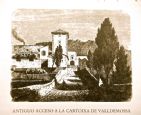 After the road was built, this access was closed. Now you enter through two portals in back. The center of this space holds a well and, on the side, various lime and plane trees. Outside, the facade is white and simple, with two windows, a central rosette and a closed portal which was never eliminated. Behind, the church has a peculiar apse over an old wall and two towers, one on either side. The one on the left has no crown, while the one on the right has an antiquated crest and roof with green tiles. It rises up above a terrace and reminds me vividly of some of our rural churches. The church’s interior is fairly large, shaped like a Latin cross. Five half-point arches hold up the longest side. Between them are cuneiform niches with windows, as is common in many Mallorcan churches. The arches rest on a type of elevated pedestal on a voluminous molding supported by smooth Romanesque columns which, in the transversal nave, are paired. The smallest nave, the transversal one, is crowned by a dome. This one as well as the two lateral branches and the four zones of the dome, between the arches, have frescoes painted on them. Three steps lead to the main altar. As for the rest, the white church is very luminous and has a fairly more Italian air to it than Spanish. The floor is covered in ceramic tiles forming a certainly beautiful figure. The stone floor in the patio leaves room for star-shaped flower beds. The corridor circling the patio has a vaulted ceiling, and, in addition to the door leading to the church, there are several others. A small portal in the Italian style leads to the open space above the facade. Through another one you access a broad domed and very long hallway with a rosette on the ends and onto which all the doors of the old cells open. These cells have all been transformed and restored today with their corresponding little gardens, serving as the summer residence for many families from Palma.
After the road was built, this access was closed. Now you enter through two portals in back. The center of this space holds a well and, on the side, various lime and plane trees. Outside, the facade is white and simple, with two windows, a central rosette and a closed portal which was never eliminated. Behind, the church has a peculiar apse over an old wall and two towers, one on either side. The one on the left has no crown, while the one on the right has an antiquated crest and roof with green tiles. It rises up above a terrace and reminds me vividly of some of our rural churches. The church’s interior is fairly large, shaped like a Latin cross. Five half-point arches hold up the longest side. Between them are cuneiform niches with windows, as is common in many Mallorcan churches. The arches rest on a type of elevated pedestal on a voluminous molding supported by smooth Romanesque columns which, in the transversal nave, are paired. The smallest nave, the transversal one, is crowned by a dome. This one as well as the two lateral branches and the four zones of the dome, between the arches, have frescoes painted on them. Three steps lead to the main altar. As for the rest, the white church is very luminous and has a fairly more Italian air to it than Spanish. The floor is covered in ceramic tiles forming a certainly beautiful figure. The stone floor in the patio leaves room for star-shaped flower beds. The corridor circling the patio has a vaulted ceiling, and, in addition to the door leading to the church, there are several others. A small portal in the Italian style leads to the open space above the facade. Through another one you access a broad domed and very long hallway with a rosette on the ends and onto which all the doors of the old cells open. These cells have all been transformed and restored today with their corresponding little gardens, serving as the summer residence for many families from Palma.
On the road that leads to La Comuna, there is an old public forest which was recently sold and a lime factory from which there is a splendid view of the Carthusian monastery, with palm trees at its base, the imposing terrace and the little semi-arid gardens. Over some picturesque rocks, the small Beata chapel rises up. From its portico we can observe the sea on the northern part and the spacious plain. Its construction includes a vault ceiling and an ugly, coarse altar with a bas-relief of the Blessed, with some rosaries and sailors’ caps hanging from the walls like votive offerings. The chapel has been recently and tastefully remodeled.
A partially paved path seeks out Na Fàtima; not far, to the left, a spring bubbles up under a domed cover. After crossing through a grove of pines, we come to a hollow with olive trees below the heights of Na Fátima and known as Ses Estelles. A steep rock path leads to the summit of Fàtima where we can still see three small towers with holes to hold flags used for geodesic measurements, all at 650.56 m above sea level. We have to say that the panoramic view is impressive: closed-off Son Salat valley, beautiful Valldemossa with the Carthusian monastery extending to Son Moragues and Son Mas, and, in the distance, the sea along the northern coast; farther beyond are the mountains of Son Moragues, the majestic peaks of Teix and, at their feet next to the always green grove of Holm oaks and in the middle of a hollow populated by olive trees, Pastoritx.
We go over Puig des Serral des Pi and continue past some plots of vigorous olive trees. An aqueduct with twelve segmental arches and six half-point ones takes the water used only for irrigation from a spring to Pastoritx. In front of the house are two beautiful hackberries. A half-point arch entrance, presided over by a coat of arms and battlements, leads us into the modernized house. A cistern cut into the rock occupies the central patio, the back of which is closed by three new diminished arches. The right and left sides are reserved for the “tafona” and the stables, respectively.
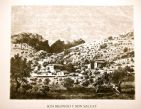 Son Brondo has a wide stretch with three tall palm trees and a view over the lower “horts” (gardens) with orange trees and small square houses, Na Fàtima, Mola de Son Pacs and the dark Son Matge house in front of some Aleppo pines. Son Brondo is a majestic, recently expanded building. Its facade has seven windows and a half-point arch portal over which a covered balcony with balustrade stands out. The inside of the balcony has been prettily tiled. Half of the house is completely new, and behind it is a fountain next to a hackberry. In the inner patio, a recently built staircase begins. To the left of the entrance is the chapel, and, in the back part of the house, a beautiful “terrat” with balustrades opens up, three segmental arches supported on rustic pilasters up front and two more arches on the sides.
Son Brondo has a wide stretch with three tall palm trees and a view over the lower “horts” (gardens) with orange trees and small square houses, Na Fàtima, Mola de Son Pacs and the dark Son Matge house in front of some Aleppo pines. Son Brondo is a majestic, recently expanded building. Its facade has seven windows and a half-point arch portal over which a covered balcony with balustrade stands out. The inside of the balcony has been prettily tiled. Half of the house is completely new, and behind it is a fountain next to a hackberry. In the inner patio, a recently built staircase begins. To the left of the entrance is the chapel, and, in the back part of the house, a beautiful “terrat” with balustrades opens up, three segmental arches supported on rustic pilasters up front and two more arches on the sides.
Crossing over the creek which descends from the Sa Baduia valley, the domain of Holm oaks and walnut trees, we come to Son Salat. Underneath the house, a trained vine on eight octagonal columns leads to the “hort”. Son Salvat de Coma-sema has a small patio bordered by two wings of the dwelling. The one on the left, with an arch at its end, holds a bell. Behind the house is an “aljub” (cistern) which collects the water from the “hort nou” (new garden) found above the house. It has a beautiful wood staircase which connects with the “hort” via a double ramp.
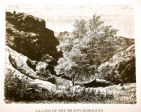 We start back at La Coma. Along the creek which crosses the valley between plantations of olive and carob trees we reach a steep hill with a separating wall which closes off the forest belonging to me and called Es Cairats. The path to Teix climbs up it, seeking out Coll de Sóller pass, the shortest but the most difficult route by far between Valldemossa and Sóller. We’ll take this path to reach the Es Teix peak, the tallest in the Valldemossa range. All the slopes are lush; we see Aleppo pines on the left. The path is amongst the most treacherous and winds up the foothill, leaving behind a branch which runs through s’Abeurada to Son Moragues and passes by the “Casa de Neu” (snow cabin) belonging to said estate. Under the shade of an old black poplar, if certainly not the place with the greatest opportunity of receiving snow compared to other spots located higher up, it is the most accessible to later transport it down. Upon reaching the summit, the path runs along a flat stretch until reaching the house at Teix, next to Coll de Sóller pas which opens up finally onto that town.
We start back at La Coma. Along the creek which crosses the valley between plantations of olive and carob trees we reach a steep hill with a separating wall which closes off the forest belonging to me and called Es Cairats. The path to Teix climbs up it, seeking out Coll de Sóller pass, the shortest but the most difficult route by far between Valldemossa and Sóller. We’ll take this path to reach the Es Teix peak, the tallest in the Valldemossa range. All the slopes are lush; we see Aleppo pines on the left. The path is amongst the most treacherous and winds up the foothill, leaving behind a branch which runs through s’Abeurada to Son Moragues and passes by the “Casa de Neu” (snow cabin) belonging to said estate. Under the shade of an old black poplar, if certainly not the place with the greatest opportunity of receiving snow compared to other spots located higher up, it is the most accessible to later transport it down. Upon reaching the summit, the path runs along a flat stretch until reaching the house at Teix, next to Coll de Sóller pas which opens up finally onto that town.
Thanks to the presence of a group of elms and black poplars and the magnificent spring called Sa Font d’En Seguí which bubbles up from a cavity to the left of the road, the house enjoys the most healing coolness.
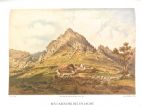 To the right is a ditch gathering the water from Sa Font de s’Aritja spring. After crossing over a separating wall and leaving behind a group of black poplars, we come to a beautiful grove of Holm oaks from which there is a precious view of Serra d’Alfàbia range. A bit farther along, a new separating wall marks the spot with the best views over the valley of Sóller with its so classic shapes. We reach a path and come to a pass and then a plot and four old houses called the Cases del Rei En Jaume. Said king lived in them for a time with the duly fulfilled hope of mending his poor health with the pure mountain air found here. One side faces Sóller, and the other overlooks Comellar des Gorg. To the right is the peak of Teix, to the left the nearby Mirador and, beyond that, Puig de Son Pere and Serra de s’Alqueria d’Avall.
To the right is a ditch gathering the water from Sa Font de s’Aritja spring. After crossing over a separating wall and leaving behind a group of black poplars, we come to a beautiful grove of Holm oaks from which there is a precious view of Serra d’Alfàbia range. A bit farther along, a new separating wall marks the spot with the best views over the valley of Sóller with its so classic shapes. We reach a path and come to a pass and then a plot and four old houses called the Cases del Rei En Jaume. Said king lived in them for a time with the duly fulfilled hope of mending his poor health with the pure mountain air found here. One side faces Sóller, and the other overlooks Comellar des Gorg. To the right is the peak of Teix, to the left the nearby Mirador and, beyond that, Puig de Son Pere and Serra de s’Alqueria d’Avall.
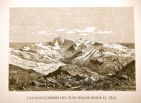 Teix’ summit is easy to access and offers extremely gratifying views. The most beautiful image is, without doubt, the one of Puig Major with Lluc in the distance and the foothills which descend to the sea up to the heights of La Costera. A valley of plowed fields opens up between the peaks of the latter, where a triangulation marker indicates a height of 1,064.04 m, and its colleagues to the west."
Teix’ summit is easy to access and offers extremely gratifying views. The most beautiful image is, without doubt, the one of Puig Major with Lluc in the distance and the foothills which descend to the sea up to the heights of La Costera. A valley of plowed fields opens up between the peaks of the latter, where a triangulation marker indicates a height of 1,064.04 m, and its colleagues to the west."
Archduke Ludwig Salvator of Austria. Las Baleares por la palabra y el grabado. Majorca: The island. Ed. Sa Nostra, Caja de Baleares. Palma de Mallorca. 1982.









